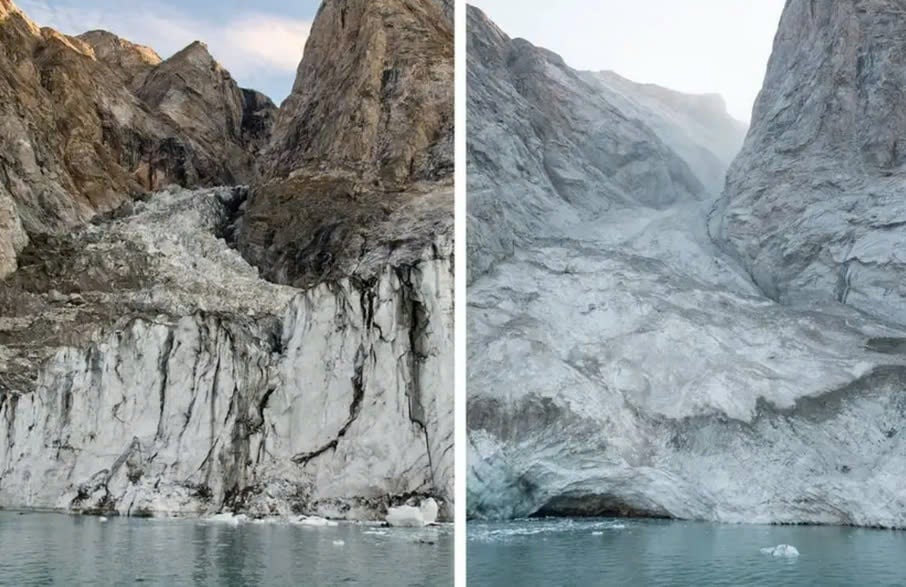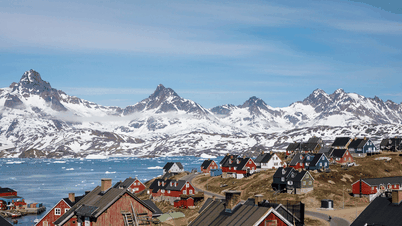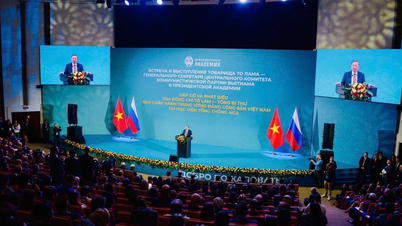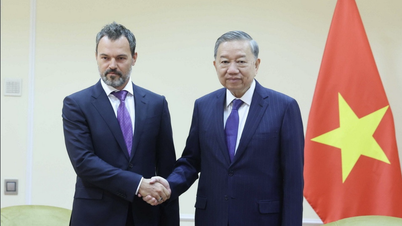Scientists around the world have been trying to figure out what that signal is for the past year. Now they have an answer, according to a study in the journal Science, and it warns that the Arctic is entering “uncharted waters” as global temperatures rise higher than ever.
Some seismologists thought their equipment was broken when they started picking up ground shaking frequencies in September, said Stephen Hicks, a co-author of the study and a seismologist at University College London, who said he was puzzled by the “unprecedented” phenomenon.

Partial view of mountains and ice at Dickson Bay in Greenland in August 2023 (left) and in September 2023 (right). Photo: Danish Army
Seismologists tracked the signal to eastern Greenland but could not pinpoint a specific location, so they contacted colleagues in Denmark, who had received reports of a tsunami triggered by a landslide in a remote area called Dickson Bay.
For nearly a year, 68 scientists in 15 countries worked together, sifting through seismic, satellite and ground data, as well as simulating the tsunami, to answer the question.
And according to research findings, for many years, the glacier at the foot of this giant mountain over 1,200 meters high has been melting, many other glaciers in the Arctic are also warming rapidly.
As the glacier thinned, the mountain became increasingly unstable and finally collapsed on September 16, 2023, releasing enough ice and rock to fill 10,000 Olympic-sized swimming pools.
And it caused a wave that literally “shook the Earth.” According to a statement from the University of California San Diego, one of the research units, “the signal oscillated with a period of up to 92 seconds between peaks, too slow for humans to perceive.”
Hicks said this was perhaps the first time scientists had been able to directly observe the effects of climate change “under our feet.” The signal traveled from Greenland to Antarctica in about an hour.
Although the event did not cause significant human casualties, it did destroy a research station on Ella Island, 70 km away from the ice avalanche.
Over the past few decades, the Arctic has warmed four times faster than the rest of the world, leading to potentially more deadly “megatsunami” landslides.
In June 2017, a tsunami in northwestern Greenland killed four people and swept away several homes. Svennevig said the threat is not limited to Greenland, but to similarly shaped fjords in other areas, including Alaska, parts of Canada and Norway.
What happened in Greenland last September “demonstrates once again the ongoing instability of large Arctic slopes due to global warming,” said Paula Snook, a landslide geologist at the Western Norway University of Applied Sciences.
Recent rockfalls in the Arctic and high mountains are “alarming signals,” Snook said. “We are melting ground that has been frozen for thousands of years.”
Meanwhile, Svennevig warns that the discovery of these natural phenomena shows that the world is changing in ways we don't expect.
Ha Trang (according to CNN)
Source: https://www.congluan.vn/tran-sat-lo-tung-gay-ra-sieu-song-than-o-greenland-khien-trai-dat-rung-chuyen-post312669.html


![[Photo] General Secretary To Lam meets and expresses gratitude to Vietnam's Belarusian friends](https://vphoto.vietnam.vn/thumb/1200x675/vietnam/resource/IMAGE/2025/5/11/c515ee2054c54a87aa8a7cb520f2fa6e)



![[Photo] General Secretary To Lam concludes visit to Russia, departs for Belarus](https://vphoto.vietnam.vn/thumb/1200x675/vietnam/resource/IMAGE/2025/5/11/0acf1081a95e4b1d9886c67fdafd95ed)
![[Photo] General Secretary To Lam arrives in Minsk, begins state visit to Belarus](https://vphoto.vietnam.vn/thumb/1200x675/vietnam/resource/IMAGE/2025/5/11/76602f587468437f8b5b7104495f444d)


























![[Photo] National Assembly Chairman Tran Thanh Man attends the Party Congress of the Committee for Culture and Social Affairs](https://vphoto.vietnam.vn/thumb/1200x675/vietnam/resource/IMAGE/2025/5/11/f5ed02beb9404bca998a08b34ef255a6)






























































Comment (0)